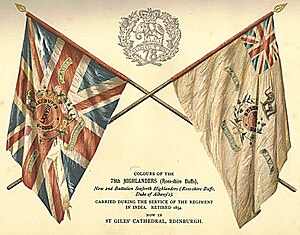78th (Highlanders) Regiment of Foot
| 78th Highland Regiment | |
|---|---|

Colours of the regiment
|
|
| Active | 1793–1881 |
| Country |
|
| Branch |
|
| Type | Infantry Regiment |
| Role | Infantry |
| Garrison/HQ | Cameron Barracks, Inverness |
| Mascot(s) | Elephant |
| Engagements |
French Revolutionary Wars Second Anglo-Maratha War Napoleonic Wars First Anglo-Afghan War Anglo-Persian War Indian Rebellion |
The 78th (Highlanders) Regiment of Foot was a Highland Infantry Regiment of the Line, raised in 1793. Under the Childers Reforms it amalgamated with 72nd Regiment, Duke of Albany's Own Highlanders to form the Seaforth Highlanders in 1881.
The regiment was raised by Francis Humberstone MacKenzie, Chief of the Clan Mackenzie, as the 78th (Highlanders) Regiment of Foot (or The Ross-shire Buffs) on 8 March 1793. First assembled at Fort George in July 1793, the regiment embarked for Holland in September 1794 for service in the French Revolutionary Wars. The regiment saw action at the defence of Nijmegen in November 1794. In a bayonet attack there the regiment lost one officer and seven men; a further four officers and 60 men were wounded. The regiment returned to England in April 1795 and then took part in the Battle of Quiberon Bay in June 1795 and the landing at Île d'Yeu in September 1795.
The regiment also took part in the successful attack by a British fleet under Sir George Elphinstone on the Dutch Cape Colony, then held by the forces of the Batavian Republic: the attack led to the capitulation by the Dutch Navy at Saldanha Bay and the capture of the colony by British forces in summer 1796. After returning home, the regiment embarked for India in February 1797 and saw action at the Battle of Assaye in September 1803 during the Second Anglo-Maratha War. During the battle the regiment were tasked with retaking the Maratha gun line.
...
Wikipedia
